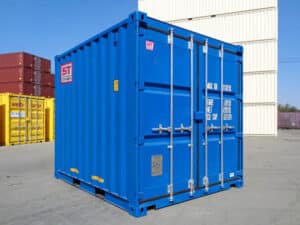
When it comes to purchasing or renting* shipping containers for various uses, you might notice that 10-foot containers are often more expensive than their 20-foot counterparts, despite their smaller size.
This oddity can be attributed to several key factors related to production, demand, and logistics.
* Here at ST Containers we don't currently charge more for rental of 10ft containers - great news for those of your wanting to hire or rent a 10 foot unit.
1. Production Costs and Economies of Scale
The primary reason for the higher cost of 10-foot shipping containers is tied to production processes and economies of scale. 20-foot and 40-foot containers are manufactured in large quantities, benefiting from economies of scale that significantly reduce the cost per unit. In contrast, 10-foot containers are not standard sizes in the shipping industry and are really flying out of the far east like their 20 and 40 foot cousins. In fact, they are typically created by cutting down larger containers, which involves additional labour and material costs. This customisation process is another contributing factor to the higher price of 10-foot containers.
2. Demand and Availability
The demand for 10-foot containers is relatively niche compared to the more commonly used 20-foot and 40-foot containers. This lower demand means that fewer 10-foot containers are produced, used, and available in the marketplace. As a result, suppliers may price them higher due to their limited availability and the specialised nature of their production.
3. Logistics and Handling
Logistically, handling smaller containers can be more complex and less efficient. Shipping and transportation systems are optimised for standard sizes, meaning that non-standard sizes like 10-foot containers may incur higher shipping and handling costs. Additionally, storing and stacking these smaller containers in depots and storage yards can be less space-efficient, contributing further to the increased costs.
4. Customisation and Modifications
10-foot containers often require significant modifications to meet specific needs, such as adding doors, vents, or insulation. These customisations increase the overall cost of the container. In many cases, businesses and individuals choose 10-foot containers for their specific dimensions, which are suitable for tight spaces or particular applications, thus justifying the higher expense for the added convenience and customisation options.
5. Market Trends and Economic Factors
Market trends and economic factors also play a role in the pricing of shipping containers. Fluctuations in steel prices, changes in manufacturing costs, and shifts in global trade dynamics can impact container prices. Recent disruptions in global trade have caused temporary price spikes for all container sizes, including the less common 10-foot units.
Conclusion
While 10-foot shipping containers are more expensive than 20-foot containers on a per-square-foot basis, their higher price is justified by the additional labour involved in their creation, lower economies of scale, specialised handling requirements, and the customisations often needed for specific uses. Despite the higher cost, 10-foot containers remain a valuable solution for businesses and individuals needing compact, versatile, and customisable storage and space options.
For more information on purchasing or renting 10-foot shipping containers, feel free to contact us at ST Containers. We are here to help you find the perfect container solution to meet your needs.